The Royal Navy has secured a contract valued at approximately £20 million for the procurement of advanced unmanned aerial technology equipped with cutting-edge surveillance sensors from Thales.
The technology will be integrated into the S-100 unmanned air system provided by Schiebel.
From 2024, this sophisticated and flexible unmanned air system, known as “Peregrine,” will provide real-time imagery and radar data to Royal Navy vessels on the front line.
https://twitter.com/geoallison/status/1623995050181926912
This addition to the Navy’s capabilities will enhance its ability to conduct round-the-clock surveillance of potential threats in the Gulf region, and support allied and partner forces in various missions, including anti-piracy, anti-terrorism, and anti-smuggling operations.
Peregrine’s designation as a tactical unmanned air system underscores its important role in the Navy’s operations, and the name “Peregrine” itself has strong historical ties to the Fleet Air Arm.
Rear Admiral James Parkin, the Royal Navy’s Director Develop, said:
“I am delighted that we are at the stage where this excellent capability is about to be introduced into the front line. As a system both deployed onto, and integrated into, warships and auxiliaries operating in congested and complex areas of the world, the Peregrine aircraft offers what the Royal Navy needs in order to respond to the wide variety of threats that we are facing today.
Today is also a key milestone in the Fleet Air Arm’s evolution to a mixed crewed and uncrewed fighting arm of the Fleet, and we are anticipating learning many lessons as such technologies continue to develop and offer new opportunities for the current and future Navy.”
Andy Start, CEO of Defence Equipment & Support who awarded the contract, said:
“The DE&S RPAS team have delivered a contract which will see a rapid development and deployment of a key Remotely Piloted Air System for the Royal Navy. Due to the collaborative approach we have taken with industry, the Navy shall be receiving a mature air system which is able to detect threats at range, protecting British interests in the Gulf.”
The air system – which takes off from the ship’s flight deck like a helicopter would – will be the first uncrewed rotary wing aircraft to operate alongside a Wildcat helicopter, allowing for round-the-clock aerial surveillance in a timely boost to the Royal Navy’s operational capability.
The high-definition imagery and radar data from Peregrine will be fed directly into the ship’s Combat Management System, allowing the command team to have good situational awareness and make rapid operational decisions.
Peregrine will be deployed directly into an operational theatre from mid-2024, initially for two years, with the option to extend. This foundation based on operational lessons will give the Royal Navy valuable experience and understanding of the use of uncrewed systems in this role ahead of further decisions and investments through the Future Maritime Aviation Force programme.


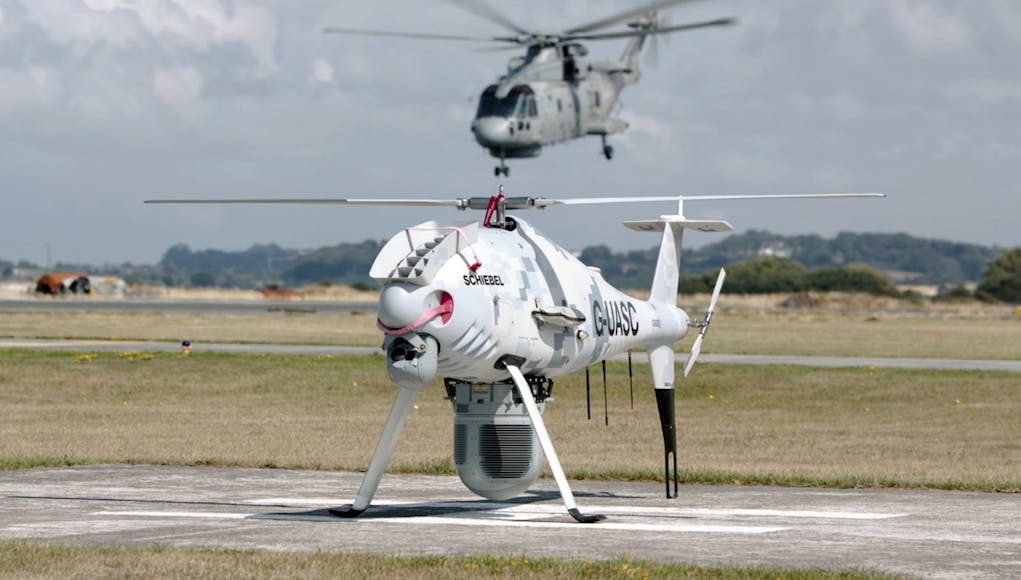

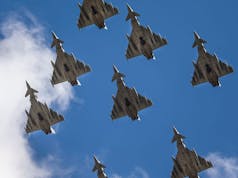
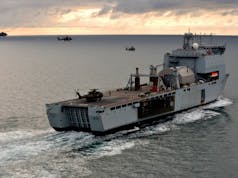


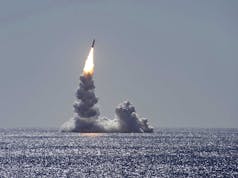

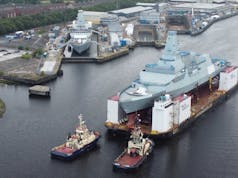



A very useful addition to the fleet with six-hour endurance and a range of 97nm.
“Thales is the prime contractor and is providing their I-Master radar, a compact, lightweight airborne surveillance radar that offers ultra-fine Synthetic Aperture Radar (SAR) imagery, Maritime Moving Target Indication (MMTI) and Ground Moving Target Indication (GMTI) modes.
I-Master was first integrated with the S-100 in 2013 is capable of detecting small and slow-moving targets. Thales says the radar can detect ships at up to 100km, vehicles at 35km and infantry movement at 15km. (The I-Master radar can be seen in the main image above as the main payload carried below the aircraft. The EO camera is mounted in the nose.)”
Interesting that the sensor data is fused from the off.
Suggests to me that some flavour of CEC already exists, at least as far as radar/threat picture, in the BAE CMS?
That was a separate contract for “Project FTUAS” given to BAES, I think in 2021. It always seemed strange that the integration was done before the drone selection was announced. This announcement has been a long time in the waiting from the UOR in 2020. Originally expected to be IOC this year, it got pushed back to 2024 and was last heard heading for HMS Lancaster and the Gulf specifically.
Yes, that is definitely good news. Unbelievable really, that the primary airborne Recce vehicle (Wildcat) still can’t achieve what this drone can. Yes, I know they are destined to receive link 16 or whatever, but still….
Why didn’t we have this capability 5-10 years ago? These things have been around for the best part of a decade or more.
This is a loan of one unit, it’s hardly good news or well bad news. It’s just another in the long list of demos, without funding for a purchase. They would certainly make a big difference to the capability of the river class in policing role if brought.
It would certainly make a difference to whatever unit carried them, they are not overly expensive or complicated for what they provide capability wise. Just but about 10-15 and utilise as seen fit.
That wouldn’t break the bank nor impinge on any of the other projects we are trying to get up and running over the next decade or so.
It’s a cheap win imo.
no, experiment perchase.
Wow great another test and evaluation for a UAS. Seriously why can’t the Navy just buy something instead of initiating a new program every few years then starting agin from scratch.
Maybe because the previous tests determined that the system didn’t add much to the ships installed systems?
Two years is quite a long time to try something in the drone world.
This probably wasn’t good enough for peer level stuff, although it probably outclasses most Russian systems as it switches on, but is quite good enough for counter narcotics and counter piracy or gulf duties.
It is the kind of thing that could be put in a temporary hanger on a River or Bay TBH as it is quite small.
Even if the ship had another bird on board it might be worth using the drone as it will be much, much cheaper to run.
The RN started trials with scan Eagle in 2006. Contracted it in 2014 then went out of service in 2017. Both the RAF and army have operated UAS over the same time as have most major navy’s. So either the RN has some major requirement that no other military service does or it’s taking the piss and Fannying about as per usual.
I suspect it’s just a question of funds as always. Endless tests means that should the money ever come available then they knew what platform they want. With the sudden decision to buy the anti ship missile without extra budget, I can’t see any funds being available anytime soon, in fact I suspect cuts will have to happen to pay for the missiles.
GDP has not grown since covid, so the 3% gives the same net amount. On the flip side inflation has meant in that time everything is going to be around 30% more expensive and combine that with the drop in the pound against the dollar. Any equipment is going to be a lot more expensive as a percentage of the budget.
I’m no expert on UAVs but I’ve always liked the look of this Schiebel. It gives, as you say, a cost effective means of doing a lot of what a Wildcat or Merlin would be used for but at a significantly lower capex and opex. In doing so, it also adds resilience the the airborne operations from ship; more assets means more continuous airborne monitoring capability in case the Wildcat/Merlin goes U/S or when the latter needs refueling etc. Given unmanned ‘vehicles’ are a growth industry and, therefore, rapidly changing market, the short term contract probably allows for flexibility, should better products come onto the market …. so we’re not left with something that’s obsolete compared to something just around the corner. I wonder if this contract allows for us to take the ‘armed’ variant …. would have needed to be written into the Requirement I guess? Not saying it would ever be used but might there be scope to mount a couple Martlet onto it. As I think I’ve mentioned on here before, it would certainly give a River class more capability and, if needed, more teeth.
DP wrote:
They knocked out a concept of it carrying two such missiles the other year:
https://i.postimg.cc/RV10jg2J/1280px-S-100-OE-VXX.jpg
Further to my last I came across an article the other day regards an even smaller micro munition which has been in development in the US for the past 5 years and has recent started field trials . Dinky isn’t the word, Lazer and GPS guidance means it is extremely accurate)
The following link takes you a short You Tube video about the 12″ and 6lb Hatchet
Thanks Farouk, comparing the picture you provided with the example at the top of the article I wonder if the Shiebel is capable of carry both the underslung sensor head and Martlets together or is it a case of either/or? I’m not sure of the respective weight of sensor head + Martlets but appreciate, if it were possible, it would mean a significant sacrifice in time-on-station and/or range.
My theory: budget. This is what one does in peacetime, develop systems and then leave it on the shelf. Should a war seem likely then production goes ahead and further funds allotted. Until then, why commit to a new fleet, when further tech advances are around the corner?
“This will inform decisions about future capabilities. “
There is that “opt out” again. Still it is good news but frustrating it is just one escort ( presumably ) rather than such a useful piece of kit being issued to each escort we have so it is fleet wide.
And yes, I know, as SB has explained further up the reasons why….but I concur with Jim.
Two years from now they will start all over again.
Concur as well, surely they’ve trialled enough of these plenty of times to have made an informed decision by now.
I think it’s more than that. This is FTUAS that has been boiling as a UOR since 2020. I don’t think they give stuff cool Navy names unless they expect them to hang around for a while. I hoped for AW Hero with an option to build at Yeovil, but the Camcopter was always the safer bet. Bristow currently maintain them for the Coastguard, and it wouldn’t surprise me if this went through them too, even if Thales is prime.
I’d say it’s for way more than one escort at that price, more like enough to equip 5…
The Royal Thai Navy procured its first two Camcopter S-100s for $19.4 million in 2020. In the same year the UAE bought 40 S-100 drones for $170m. The extras for the control station, payload, ground equipment, training and logistics are fierce.
I’d guess we got four of them. Three for the ship and one for training.
Hope so! Deployed “escorts ” then not escort.
I think the main problem is that drone technology is moving at such a rapid pace, once something is entering service, a better model is already available. Hence the ability to review after 2 years.
In which case we remain in that never ending cycle. Meanwhile others get on and operate the things. I say choose one, get on with it, gain the experience. They’re chicken feed compared to the costs of other assets, and which I know you know all this mate.
Hopefully this contract is a step in that direction. 👍
Agreed, we are a good two years late in trialing this and as such another years to come to a conclusion from a single prototype hardly seems like cutting edge at the forefront stuff. Geez the Iranians and Turks are or will be in reality years ahead of any decision we make, If I had confidence in us making the right and superior decision I wouldn’t be so anxious but I fear it will just be more delays, or wrong decisions, or right choice but too small a number at best. But I guess it’s best to have low expectations of what presently looks a good potential platform in the S-100 than the reverse.
This is just a lightweight interim constabulary option. The MoD and the RN are after Proteus for a more serious capability in the 2-3 tonne weight class, capable of sonobouy deployment, perhaps also dipping sonar, to work in conjunction with Merlin. Also Maritime Intra-Theatre Lift. Whether it makes sense to keep a smaller platform like the Schiebel once Proteus is a thing is probably why they aren’t committing to the former.
https://www.leonardo.com/en/press-release-detail/-/detail/21-07-2022-the-future-of-uk-uncrewed-military-vtol-technology-is-secure-onshore-as-mod-gives-green-light-to-leonardo-for-proteus-demonstration-flight
Oh and here’s a link to an April 2021 Navy Lookout article that pre-dates the Leonardo award. It discusses the suite of options the RN is evaluating/pursuing, including Proteus.
https://www.navylookout.com/novel-technologies-in-anti-submarine-warfare/
Personally I prefer the methodical approach here, versus the debacle of the Watchkeeper program. YMMV 😉
Thank you GHF.
RN seems to be getting lots of pressies 🎁 at the moment!! 👍🏻
They need them. Capability gaps being slowly filled that shouldn’t have been left to exist.
The speed of acquisition at the moment suggests the RN already had a list of what it wanted and was just waiting for the go-ahead; ie money.
So unit cost of Schiebel S100 camcopter is £375K list price. So 20 million should deliver around 25-30 airframes once spares, training and other interface costs accounted for. Not bad. One for each major surface warship and RFA. Useful role for RFAs out on hurricane duty in the Caribbean and for other humanitarian aid/ disaster relief operations.
Well lets see actually how many are contracted for as its not a purchase and don’t see it being more than a couple actually operational as that amount will also cover the support, training needed to operate it.
This is a perfect system for the OPV the RN has and a good sound addition for the larger units. Perhaps the FAA will stand up an additional front line unit to operate them?
We do however need to have these online for more than just a couple years. 10+ would be a better outlook for them and mean we the taxpayer get a positive return in our investment.
Come on RN, sort it out and make this a longer period and no more wasting time on such short periods, we would also get a much better deal when its long term. Value for money to the taxpayer and a much needed uplift to the Fleet.
The costs can become eye-watering. Australia has a project to equip 20 ships, including the 12 Arafura OPVs, and the project costs are AUD 1.3bn.
The widely circulated figures from 2005 was $400k for a camcopter, but $2m for a complete setup (2 copters, ground control station, training, etc, etc). So I’m actually thinking more like 10 sets (2 camcopters per set).
I suspect the GP T23s will get them first, with the 5 x T31 inheriting them.
The remaining 5 to give the Rivers B2 an air capability?
Sean wrote:
To be fair, they have been trialing it since 2021. Thales knocked out a info brief on the matter in Sept 2021 (The video included inside it, is a pretty good eye opener)
November we had the Sea Ceptor announcement for T45, then the NSM announcement, now this. Definitely seems to be a bit of a spending splurge at the moment.
I think the PR is, in the lingo, being profiled. So there is a steady drip feed of good news stories.
Wouldn’t surprise me 🤷🏻♂️
Money being reallocated from the two T23’s being taken out of service early?
Plus the tail end of Doris’ £16Bn.
I do think Hunt is allowing a bit more flexibility where it can be shown to save money.
Also helps if the purchases are relatively small ticket.
This is where I got a bit annoyed with Healey’s comment about the smaller programs being sacrificed for the mega projects. It just isn’t true. And if you don’t incrementally get on with the bigger programs then they never happen!
As Graham Moore pointed out in another thread army actually had plenty of smaller buys that went well. It just messes up the big buys every time.
Well in 2018 the annual running cost was £11m, though obviously you’re still paying the crew if you’ve taken the ship out of service. But they’ll certainly have saved millions there to spend elsewhere.
But yes £20m for Camcopter is small-change in the defence budget let alone HMGs spending. So small I doubt the Treasury would even be aware of the purchase.
Yeah Healey was unimpressive, though Labour has bigger idiots on their benches – Abbot, Lammy, etc
I’m trying to think of Army procurement cockups…
• Ajax is the current stick they’re beaten with, though hopefully 🤞🏻
• Warrior upgrade cancellation is another.
• Watchkeeper…
And I know there’s concerns about reduced numbers on new Apaches and CR3 upgrades.
It is more the LIFEX costs that are avoided on one hull?
Well the best figure I can find is £600m for all 13 frigates. There’s obviously programme costs that are independent of the number of frigates, but if we ignore those then that’s £46m per frigate – it also ignores whether PGMU is done during LIFEX.
HMS Monmouth was decommissioned in 2021 after being alongside since 2019. So that’s 1 LIFEX not performed…
What’s the other Type 23?
PGMU costs aren’t included in the LIFEX costs.
They are running a good PR operation: no doubt.
Nope, just pleased to finally see the RN finally getting all this kit. Some of our allies have had the camcopter for a decade FFS! 🤷🏻♂️🤦🏻♂️
Feel like these would be useful on the rivers. Stick a container on the back to act as a hanger, then you have a good little asset to help hunt pirates and smugglers.
Also isn’t this the helicopter drone they showed off with martlet?
Yes it is.
I still like the idea of sticking them on the 30mm mounts. Would be useful on the rivers, give them a little more of a punch, but since they are getting replaced by the 31s in the forward deployed role it would be an expenditure they don’t really need.
This would be perfect for the Rivers for ISR if it wasn’t for how expensive they are. They can be container operated. I think they normally need something like a three person operating team, which would be significant bump for the Rivers. I wonder if fewer people are needed when it’s intergrated into the CMS.
I’d definitely have a couple on HMS Medway for hurricane season overflights as well as for constabulary duties.
Looks like a good idea. 2 of these with Martlett and pods carrying with more Martlett or Brimstone equals a useful light strike role for the Rivers.
The River class would be better served with some type 31 gun armament, BAE 56mm or Bofors 40mm to give them a reasonable CIWS and defence against FAC/ UAVs, Helos
They might get the 40mm if the RN decides they have to many guns in service. I guess we will find out when the specs come out for the 32 and the 83. I’d imagine if the specs come out for the 83 and they have ditched the 30mm for some 40mm then most likely they will be getting rid of the 30mm.
However you could also say is it worth spending the money on the rivers after the 31s come into commission, as most people seem to think they will just come back to home waters for fishery protection and other low risk duties. Don’t need to upgrade the gun for that especially with the budgets being so tight, would rather spend the money on something else.
Why withdraw the 30mm?
There are loads of 30mm on
Rivers
T45
Albion
Bays
RFA mostly have 30mm mounts
So to change all of them to 40mm would be very, very expensive. Particularly is it was with 3P ammo. It would make no sense for types that are nearing the end of service life.
The counter argument is that it is actually a small amount of money to spend to significantly increase the onboard defence of all of the ships.
Much better to run up 40mm on the T31, T26 and T45 -> T83 and then phase 30mm out.
I suspect the reason the 30mm wasn’t fitted to QEC was that it will get 40mm.
I’ve no idea why Rivers would ever need anything better. If you start up arming them they are then ‘warships’ and will get sent to war as they are ‘what we have’.
A bit pedantic but a photo of a drone needs some sort of object for size comparison. Is this thing a full size chopper or switchblade sized?
if I am correct, from what I recall, I think the rotor blades may be about waist high.
Believe you are correct there.
S100 is @10 ft long with MTOW of 440 lbs.
I remember seeing this and similar vehicles in videos, and it wasn’t that big.
It would be nice to have a UAS with a multi-role function that could carry light cargo to surveillance. If you have that function for one vehicle on a ship, it could cause operation conflicts.
I missed that the Thales/Schiebel exercises at REPMUS in Portugal were sponsored by the Royal Navy, according to UAS Weekly (not one of my normal reads).
It goes on to talk about the ability to relay sonobuoy data back to the ship that was tested there. Lancaster, which was also at REPMUS and has been mentioned several times as the destination for the drones over the last year or two, isn’t an ASW frigate, so it’ll be interesting to see how that aspect plays out.
How many S100s does £20 million purchase. If hope for at least 10. Anyone know?
Most of the figures bandied around on the internet are $400k for one copter, and $2m for a full-package of 2, plus ground-station, plus training etc. but these prices date from 2005 when they were still developing it. While inflation would push the price up, the development costs should have been amortised by now and manufacturing costs reduced. So 🤷🏻♂️
Scrolling down the comments it seems people have either overlooked or are unaware of the Proteus program when being critical of progress and/or ambition. Leonardo has a £60 million contract for Proteus awarded back in 2022.
A Proteus 2-3 tonne platform will be a far more capable platform that may end up replacing the short term contract Schiebel solutions or ant other lower capability platform, in addition to supporting war fighting capabilities, specifically ASW sonobouy deployment and perhaps dipping sonar.
https://www.navylookout.com/novel-technologies-in-anti-submarine-warfare/
I would also add that its easy to spend money, sometimes a lot of money, harder to end up with the right solution in a fast moving market, Watchkeeper anyone?
Proteus will be too big for long deployments of the Rivers and unfortunately Peregrine is too expensive. I wonder if Puma at the moment is as good as we can do. They were testing it on Tamar before it went to the Indo-Pacific. We really need something UK built, relatively cheap (<£250,000), with endurance, that can handle EO/IR and a small radar (<30kg, <1kW) and link back over the horizon information in real time. And can operate out of a 20′ container.
Peregrine is an interim program that works for T23 or Rivers, allocated as required and can of course be container rather than hanger based for the Rivers. Timing for a Proteus production solution would mean its likely to deploy in line with T31s coming into service, along with the remaining T23s and T26s. Not likely to have earlier availability.
So then, T31 with Proteus takes over from the forward deployed River B2s. The latter return for use in domestic waters, replacing the B1s that were supposed to have gone by now but were extended in service. If the River B2s need UAS for domestic, Falklands and Caribbean roles then none of those would need long deployment away from a base, so aren’t dependent on container based solutions. It then becomes a decision as to whether the RN decides to keep something like Peregrine as is, or standardises on Proteus along with Malloy T-150/400 for UAS. My money is on the latter standardisation given what the RN illustrated in their Future Maritime Aviation Force 2030 vision.
If Proteus coincides with the advent of the Type 31s it also coincides with the advent of the T26s. I think we’ll have to see where it’s aimed. The Malloys don’t have the endurance or power for the ISR role. Drain a substantial fraction of a kilowatt from the batteries to run a search radar, and how long would the current sub-hour endurance drop to?
I’ve never been in favour of replacing River B1s with the B2s. First, the B1s are overspecced for domestic fisheries protection, and we can easily get away with something smaller like the Cape class instead of using the even larger, more overspecced B2s. Why waste a ship that’s not good enough to pose a credible threat to warships, but far too good to waste on catching illegal fisherman and smugglers?
Next, the B2s are better in their current presence role in A-P than the Type 31s would be. A Type 31 would have a very different role if based out of Singapore or Brunei. HMS Spey just went from South Korea to Vietnam, presumably through the South China Sea. A warship like the Type 31 would send a very different message doing that. The B2s can give more sea days, more port visits and more joint exercises and training, with fewer crew, and lower operating costs. If making friends and influencing people is part of the Navy’s grey-zone operating concept, the B2s are absolutely the right vessels.
We need both types forward based. However, I’d far rather see two Type 31s based in the Uk as fleet ready escorts than the return of the B2s.
Perhaps I wasn’t clear. Malloy solutions complement Proteus, I wasn’t suggesting they are an alternative to Peregrine/S-100. So the point is do the RN want a third UAS system at this level if they have those two? The Future Maritime Aviation Force – 2030 slide doesn’t show it.
Proteus is intended to support the FIND role for ASW alongside Merlin on T26. That doesn’t preclude it from above water FIND and MITL roles on T31 and Rivers, either operating independently or alongside Wildcat.
B2s aren’t limited to fishery and anti-smuggler roles in domestic waters and would be preferable over Cape-class level vessels in tougher sea condition operations around the UK, especially aiding ships in distress. Our high end T45/T26/T23ASW escorts are UK based. So in that case my preference is to maximise forward deployed T31 with rotating crews as a more effective use of the latter assets.
As to the South China Sea; any RN vessel is fully within its rights to traverse anywhere within, including the Taiwan Straits, under Freedom of Navigation. Arguing that we should deploy B2 because it ruffles fewer feathers regarding China’s illegal claims seems an odd position to take. The T31 parent Iver Huitfeldt-class was specifically designed as a low operating cost, high availability ship, so its not established that the B2s would provide more sea days, more port visits and more joint exercises and training; although clearly they should have lower operating cost with a smaller crew.
FMAF-2030 slide from March 2021 –
I agree with some of that. I didn’t suggest we should only have B2s abroad, far from it. I said we need to have both T31s and B2s forward deployed, because they do different jobs, and I was giving an example of why. Please don’t mischaracterise my “position”.
Yes, you could dual crew a T31 — I hope we do, but that requires well upward of 200 people so I can’t see it on all five ships, while rotations on B2s require less than half. Also a dual crewed T23 such as Montrose (227 sea days in 2020, the highest availability year I have figures for) still spends far less than the 320 sea days design max for the B2s. Echo class is designed to be up to 330 and HMS Scott up to 300. These all use three watch rotations to maximise availability. I’ve seen nothing to suggest the frigates are designed to be in that league. I’ll be happy if I’m wrong.
As for a third heavierweight UAS, I haven’t given up on Vixen yet. As that may not have the juice to replace Crowsnest, we may even see yet another larger fixed wing, with higher endurance and more power. We’ll have to wait and see.
You misinterpreted my comment. I was saying that in domestic waters, B2s could do more than fishery and anti-smuggler roles. It was a response to your second paragraph that focused on domestic use of Rivers.
It will be interesting to see what level of manning is used by the RN for T31 as there seems to be a lot of flexibility, depending on role, armament and mission. The link below to the OMT document on the original IH AAW destroyer details how the Danes leveraged Maersk commercial experience to enable the basic ship to be operated with only 20 crew, with an operational ship at 100 crew and additional space for 60 mission-dependent crew members, which is very lean manning for an AAW destroyer.
Vixen, certainly as described in FMAF-2030, is an ambitious platform when it includes Air and Land Strike capability. The intent to release Merlin from AEW duties in order to focus on ASW would seem to be the higher priority for Vixen.
https://www.aspistrategist.org.au/wp-content/uploads/2014/11/OMT-Dansh-Frigate-Programme-April-2014.pdf
Wasn’t there talk of a bigger S-300 version too with a longer range more payload capacity ? Not sure of its dimensions, but might be as bit of a squeeze and mayn’t be even built yet. 😆
This
S-300: MTOW 660kg so a little over three times that of the S-100. Folded, Schiebel claim it can still fit in a 20′ container.
Thanks Jon. Yes, it’s big brother. Could be over three times more useful. Good that it can still fit into a 20′ container and presumably 2 into a 40′ container. Would save building a fixed hangar on the B2 Rivers.
Presumably, by the end of 2026 the S300 will be ready and available;
Regarding the technical specifications, according to Schiebel, the UAS is 4.8 meters long, 1.9 meter high and 0.9 meter wide. It can fly at a maximum speed of 120 knots (cruising speed 55 knots). Size apart, the true difference compared to the S-100 system is the payload capacity. Indeed the S-300 is able to carry up to 340 Kg (fuel including) and its maximum take-off weight can reach 660 Kg. This is basically three times more compared the S-100 can carry. With a 50 Kg payload, the S-300 can fly up to 24 hours (4 hours with 250 Kg).
Camcopter S-300
Camcopter S-300 compared to the S-100 (image from company brochure).
According to Schiebel, a triple-blade folding rotor system allows the storage of to S-300 UAVs and one ground control station (GCS) in standard 20-feet container. The company highlights the few accessories needed to launch or recover such UAV and its capability to be stowed and maintained in confined spaces including in ships’ hangars.
I think for me the really interesting bit was the 24 hour cover element. That suggests to me that they may be planning to deploy more than one unit to an escort and actually practice some pretty intense air operations.
after all one challenging for a future navy will be the ability to maintain constant and quite intensive air and sea autonomous operations.
These particular drones will also be a very useful for addition for the constabulary vessels ( rivers 2) especially for the North Atlantic deployment.
Task Force 59 is the USN organisation working out how to employ drones and tech in the Middle East.
Its 2 i/c has recently joined and is tellingly, an RN Cmdr, Jim Lovell.
HMS Lancasters use of S100 will no doubt be followed closely by the RN and USN.
Lots of other stuff is used out here by the USN and the RN for trials and exercises with both services working together.
Last week an Atlas work boat was out and about along with the RN operators.
Its very common to see drone boats and other stuff pottering around.
This is just some of the stuff that is out and about around here.